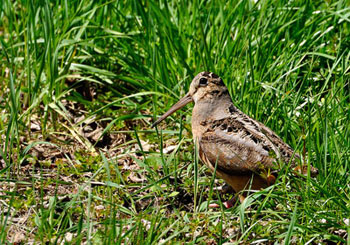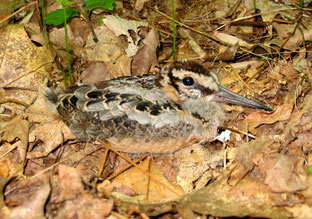Woodcock
(Scolopax minor)
Description & Range:
The American woodcock has a mottled brown back with a grayish-brown head covered with black bars across the crown. The earthy coloration helps woodcock blend in with the forest floor. These short-legged, plump birds have long, flexible bills capable of opening near the tip, even when plunged into the ground. Interestingly enough, the tip of the bill has a concentration of nerve endings which likely help woodcock sense their prey in the soil. Woodcock also have short, rounded wings which help these birds fly through dense forest cover. Adult woodcock can weigh from 6-8 ounces and can get up to 11 inches in length. Males and females look similar, though females are often larger than the males.
American woodcock can be found throughout the eastern United States and southern Canada. In Maryland, American woodcock can be found throughout the state in the spring and summer. Most woodcock in Maryland migrate to the southeastern United States, though some will overwinter on the Eastern Shore.

American woodcock by Dave Smith, Flickr
Habitat:
American woodcock live in young, second-growth forests, shrubby fields and open areas including old fields, forests clearings and bogs. Typically, males use open fields and/or clearings in the spring as part of their courtship display. However, while feeding, woodcock tend to utilize areas with dense cover and moist soil. When nesting, females typically can be found in young to middle-aged forests.

American woodcock have excellent camouflage,
photo by Bill Harvey
Diet:
Much of the American woodcock’s diet consists of earthworms due to their high fat and protein content. While foraging, woodcock will also prey upon grasshoppers, insect larvae, beetles, crickets, millipedes, centipedes and even spiders. Occasionally, woodcock will also consume seeds of grasses and sedges. Woodcock can eat up to 90% of their body weight in a 24 hour time period!
Reproduction:
Late January through February, woodcock migrate northward to the northeast U.S. and Canada. From mid-March to early April, male woodcock perform a courtship display in open areas. During the display, the male will strut on the ground and call out a nasally-sounding “Peeeent” noise (click to hear call). After strutting around, the male will then complete a series of spiraling flights before returning to the ground to strut and call again. This display will last 30-60 minutes and is performed at dusk.
Males can mate with several females in one season, and nesting usually begins around April and early May. Females make nests on the ground consisting of shallow depressions lined with leaves. Many times, these nests are built less than 100 yards from the male display areas. Typically, females lay 4 mottled eggs which are incubated for 19-22 days. After hatching, chicks take 2 weeks to develop flight feathers and are often full grown around 4 weeks of age. Most chicks remain close to the nesting area until fall migration.

American woodcock chick hiding among the leaf litter,
photo by Kerry Wixted
Behavior:
American woodcock are most active during dusk and dawn (aka crepuscular). Earlier in the day, they typically forage in dense, pole-sized forests and rest in open areas in the evening.
Sound:
American woodcock are relatively silent aside from the male display in the spring.
Management:
At one time, American woodcock were abundant throughout their range; however, recent population trends have shown a decline. Part of this decline is attributed to loss of early successional forest habitat. Because of this, several areas in Maryland such as
Millington Wildlife Management Area and
Mt. Nebo Wildlife Management Area have been managed to provide more young forest.
Woodcock are managed as webless migratory game in Maryland.
Click here to find out more about woodcock management.